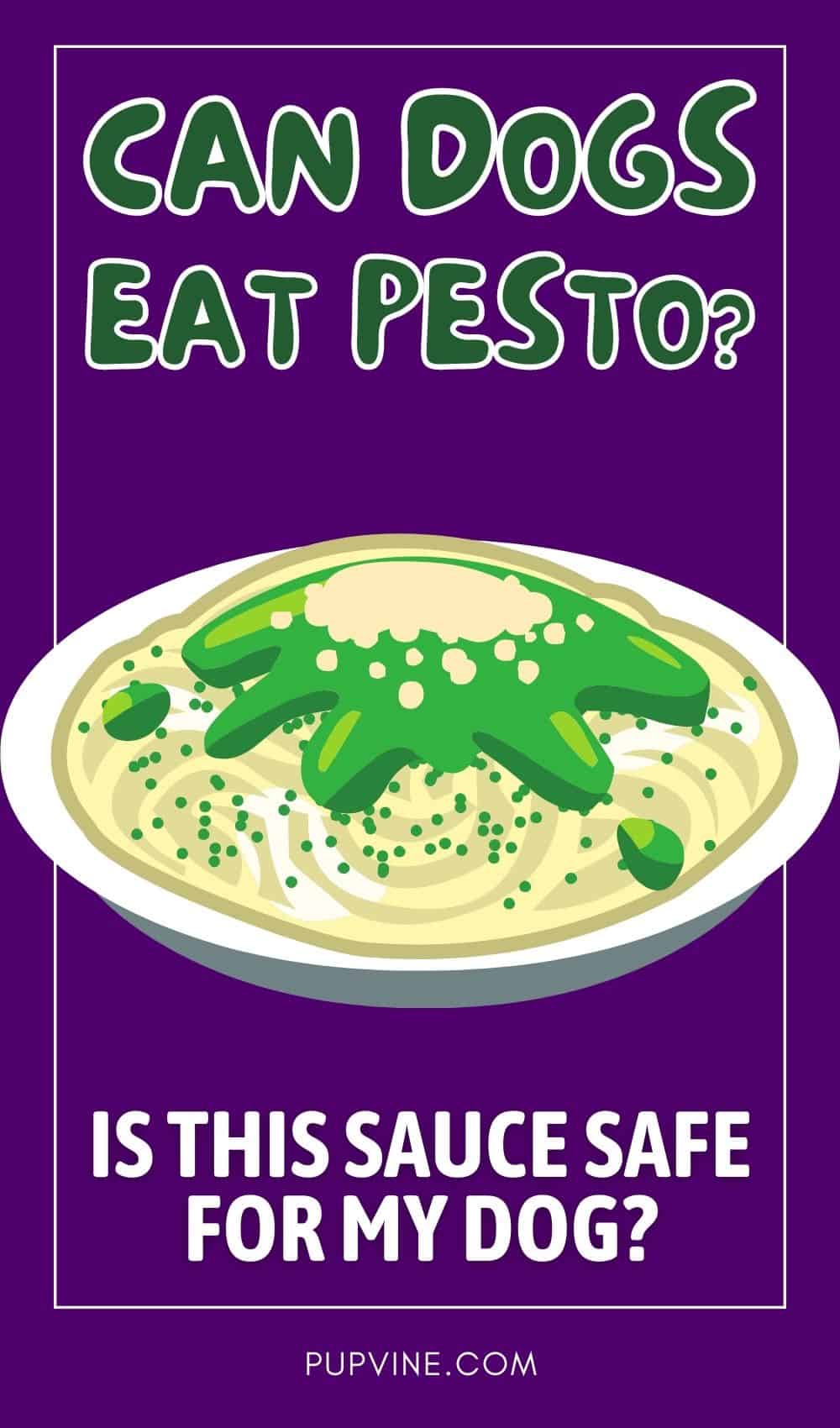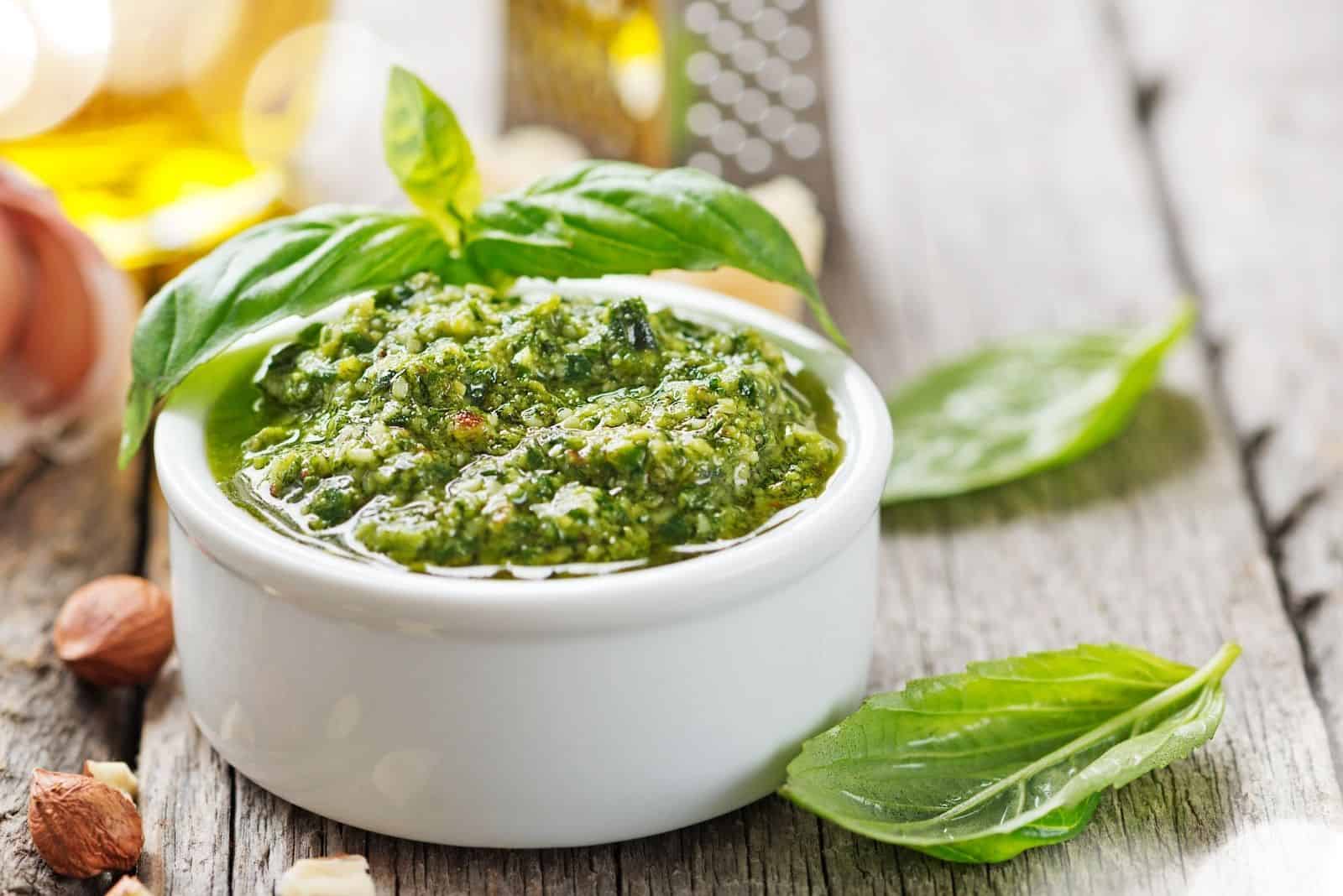Dogs are creatures of habit. We can use this fact to our advantage by creating a regular feeding schedule and sticking to it.
A regular feeding schedule helps with house training puppies, as well as adult rescue dogs who have not been taught household manners.
If your dogs are in great health and eating regularly, there’s not too much you need to do.
As long as you feed them high-quality dog food based on their size and age, your furry friends should continue to happily eat according to their regular schedule.
The amount of food your dog needs may change if:
• Your dog becomes more active or is pregnant or nursing.
• The weather is very hot or cold.
• Your dog is recovering from surgery or an infection.
Before giving them more food, make sure they are not just looking for attention and love. And if they are, serve that up instead.
The best method for feeding your dogs depends on their size and personality. If you set a big bowl of food in front of them, would they stop eating when they are full?
Or would they eat until the food is gone, regardless of hunger? Consider these two methods:
• Free-Choice Feeding – Fill their bowl with dry pet food in the morning and allow them to eat throughout the day whenever they are hungry.
This method allows them to eat more or less as their appetite fluctuates. This is a great plan for laid-back eaters.
Of course, if you are leaving food out all day for your dogs to nibble on, use dry food, which won’t spoil.
• Timed Feeding – Provide rations on a twice-daily schedule, allowing them to eat for 20 minutes before removing their bowl.
This establishes routine and perfectly proportions their calories. This feeding method is ideal for overeaters, large breeds, and obese dogs.
Every dog owner should know what kind of food is safe for their dogs. Humans love to eat certain food and want to share the food with their dogs.
Remember that food that is safe for humans may not be safe for your furry friend. Pesto is popular human food but can dogs have pesto?
What Is Pesto?
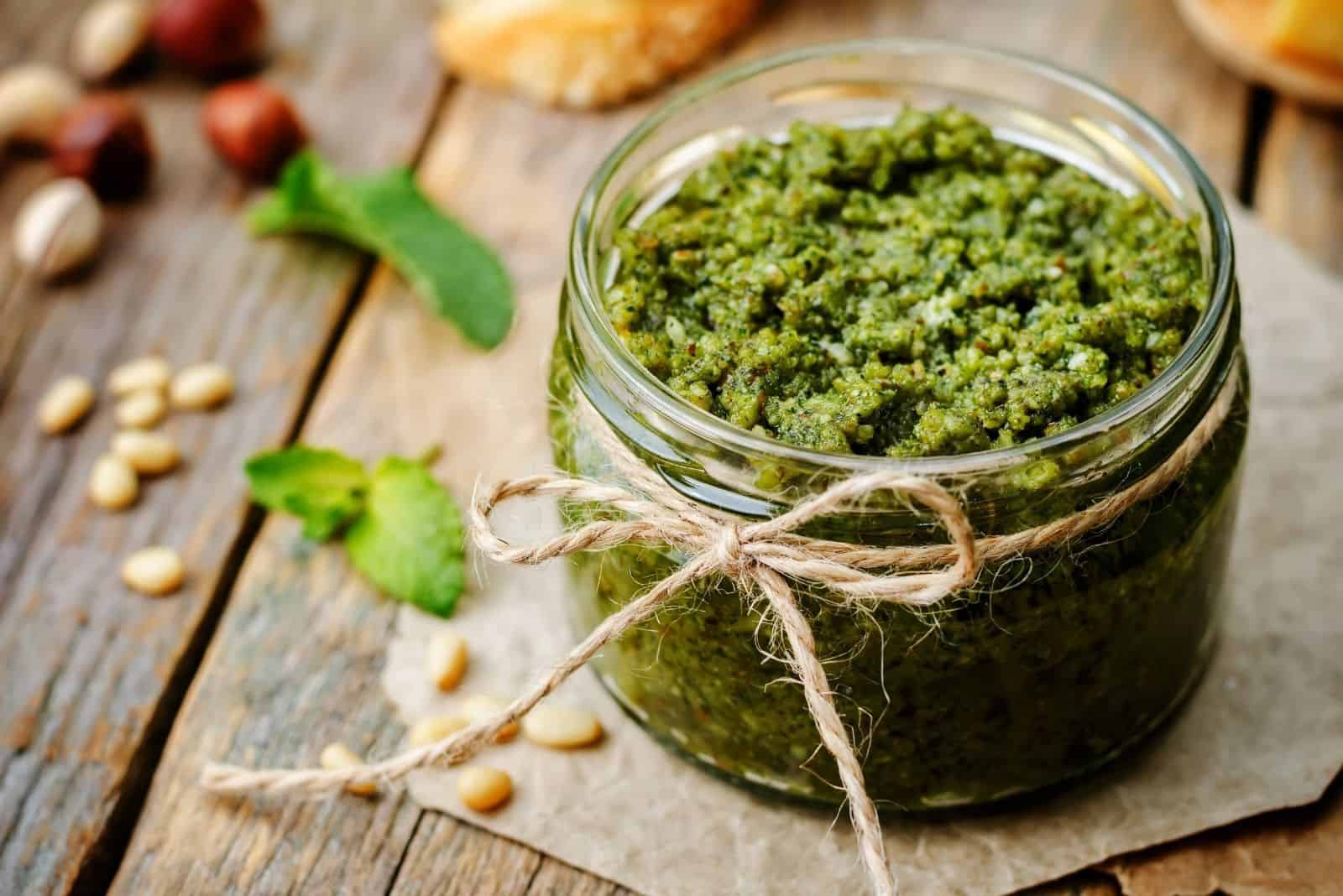
Pesto is a sauce of Italian lineage, made by crushing together a melange of simple ingredients: most famously basil, salt, olive oil, garlic, pine nuts and cheese.
It’s not only the ingredients but the method that makes it unique: the word “pesto” is actually derived from “pestle”, possibly referring to the fact that in the early days it was likely made with a mortar and pestle.
While there are thousands of variations on pesto, the one called pesto alla Genovese is probably the version you know best.
It is made with garlic, salt, a good quality extra virgin olive oil, cheese, and of course, basil from Genoa.
In Italy, there are other variations, such as pesto alla siciliana, which is similar, but with the key difference that it employs tomatoes and uses less basil.
Pesto is a very versatile sauce. It can be used on pasta, as sauce atop meat, as a bread topping, or even treated like a condiment.
Since the two of the main ingredients in pesto are cheese and oil, people should be careful in consuming it.
Because, both of these ingredients are high-calorie food.
Can Dogs Eat Pesto?
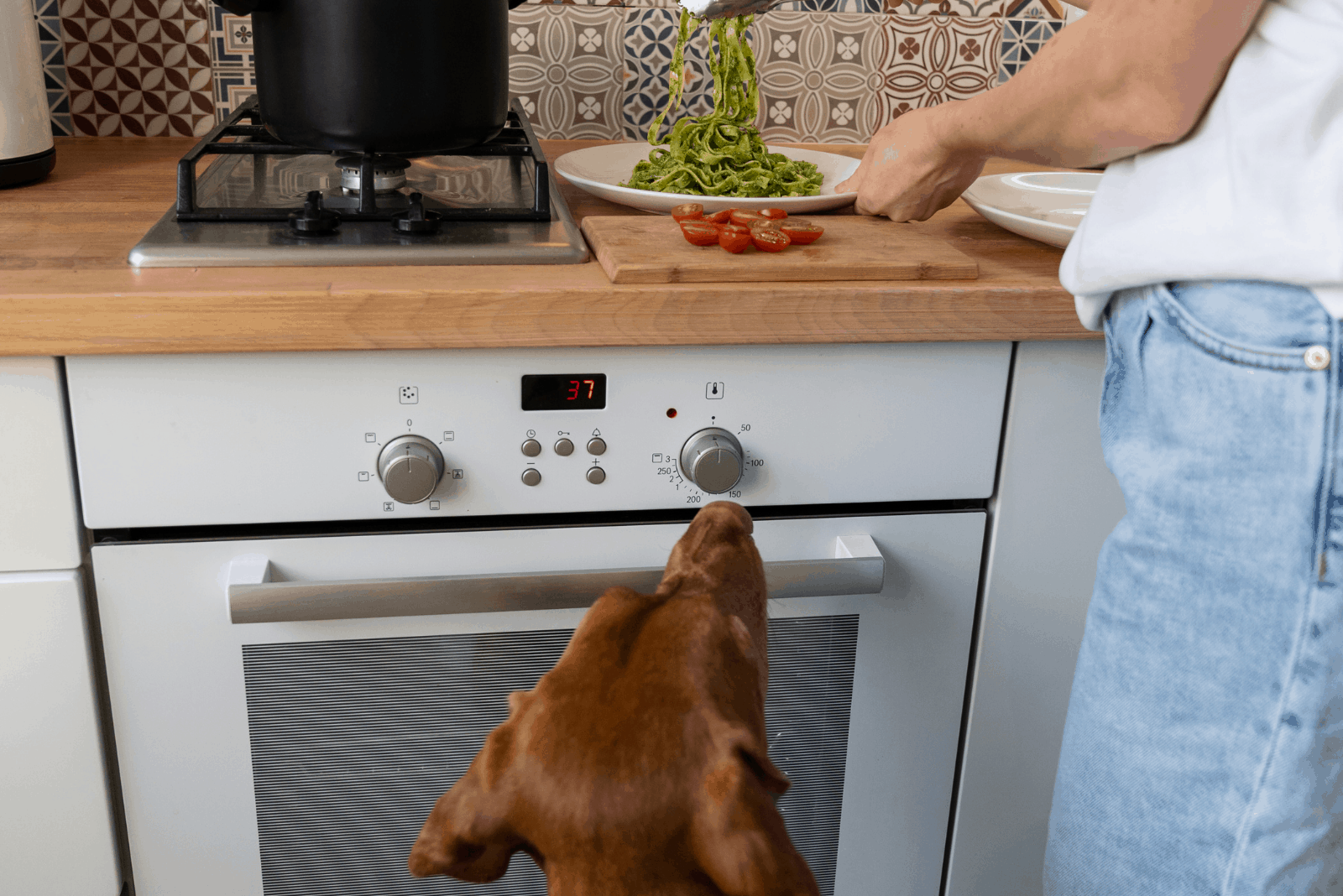
To answer your question quickly – no! Human pesto is not suitable for dogs. Although pesto is primarily made up of basil, which is safe for dogs, it contains garlic, which is known to be toxic.
It also contains olive oil and cheese, which in large amounts can cause health problems such as diarrhea, vomiting and obesity.
If your dog eats a large amount of pesto containing garlic, watch for these symptoms:
• Vomiting
• Fever
• Rapid breathing
• Weakness
• Seizures
Can Dogs Have Pesto?
As we already mentioned, pesto is not the right food for your dog due to it’s ingredients.
Let’s see why some of these ingredients are good for your dog, and others are not.
Basil
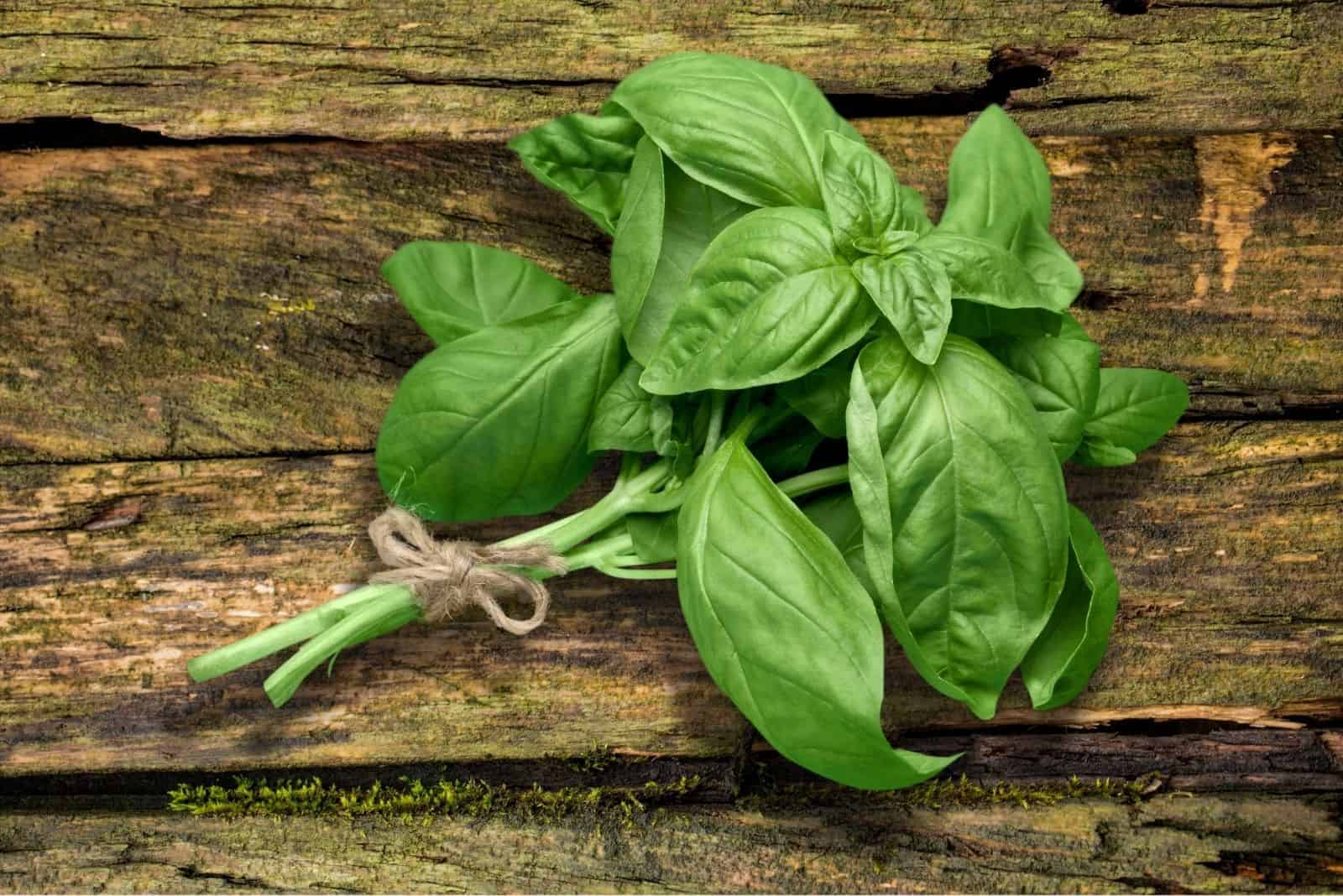
Basil is healthy for your pooch to eat in small quantities. It’s anti-inflammatory and contains a high level of antioxidants that help prevent many types of illness including cancer.
Basil also helps prevent cellular damage, calms your anxious dog, and eases arthritis pain.
You can give your dog a basil as at treat right from your garden. You can even be creative – chop it and put it on top of your dog food.
Furthermore, you can find dog treat recipes on the Internet and make your dogs delicious treats.
It’s not a rocket science; every pet owner who has some basic cooking skills can make these recipes
Here are two diy basil treat recipes:
1. Sweet Potato and Basil Biscuits
Ingredients:
• 2 1/2 cups brown rice flour
• 1 sweet potato, shredded
• 1 egg
• 1/3 cup organic coconut oil, melted
• 1 tbsp basil, finely chopped
• 1 tbsp honey
• 1/2 cup cold water
Directions:
First, preheat your oven to 350 degrees F and line a baking sheet with parchment paper.
Then, mix all the ingredients in a large bowl. Roll into small 1-inch balls and flatten with a fork. Place the balls on the baking sheet and bake for 35 minutes.
After baking, turn the oven off and leave cookies inside for another 30 -45 minutes until crisp. Cookies should be served cold.
2. Breath Freshening Dog Treats
Ingredients:
• 1 1/2 cups whole wheat flour
• 1 1/2 cups brown rice flour
• 1/2 cup ground flax seeds
• 3 large eggs
• 1/2 cup sunflower oil
• 1/4 cup water
• 1/4 cup basil
• 7 sprigs parsley leaves, chopped fine
Directions:
First, preheat your oven to 350 degrees F and line two cookie sheets with parchment paper. Then mix the flours and flaxseed in a bowl.
In a separate bowl mix the remaining ingredients. Combine the mixes until a dough forms.
Flour a clean work surface and roll the dough to 1/4-inch thick. Cut into treat sized pieces, transfer to the cookie sheet and bake for 20 minutes.
After 20 minutes turn the oven off. Live treats in the oven to crisp for 2-12 hours. When it is over, serve it to your dog.
The latter recipe has a parsley among ingredients. If you are asking yourself: ‘Can my dog eat parsley’, we have an answer. Yes, your dog can eat parsley.
Parsley is also a herb rich in a variety of important vitamins and minerals for your pet.
Parsley is a natural source of Vitamin C, A, and K. Parsley is also rich in folic acids and antioxidants.
In moderate amounts, you can feed your furry friend fresh parsley, but with the curly parts of a plant.
Parsley is high in fiber and a diuretic, meaning it helps the body flush out fluids and move foods through the digestive tract. If your dog has kidney problems, you might want to avoid this ingredient.
Garlic
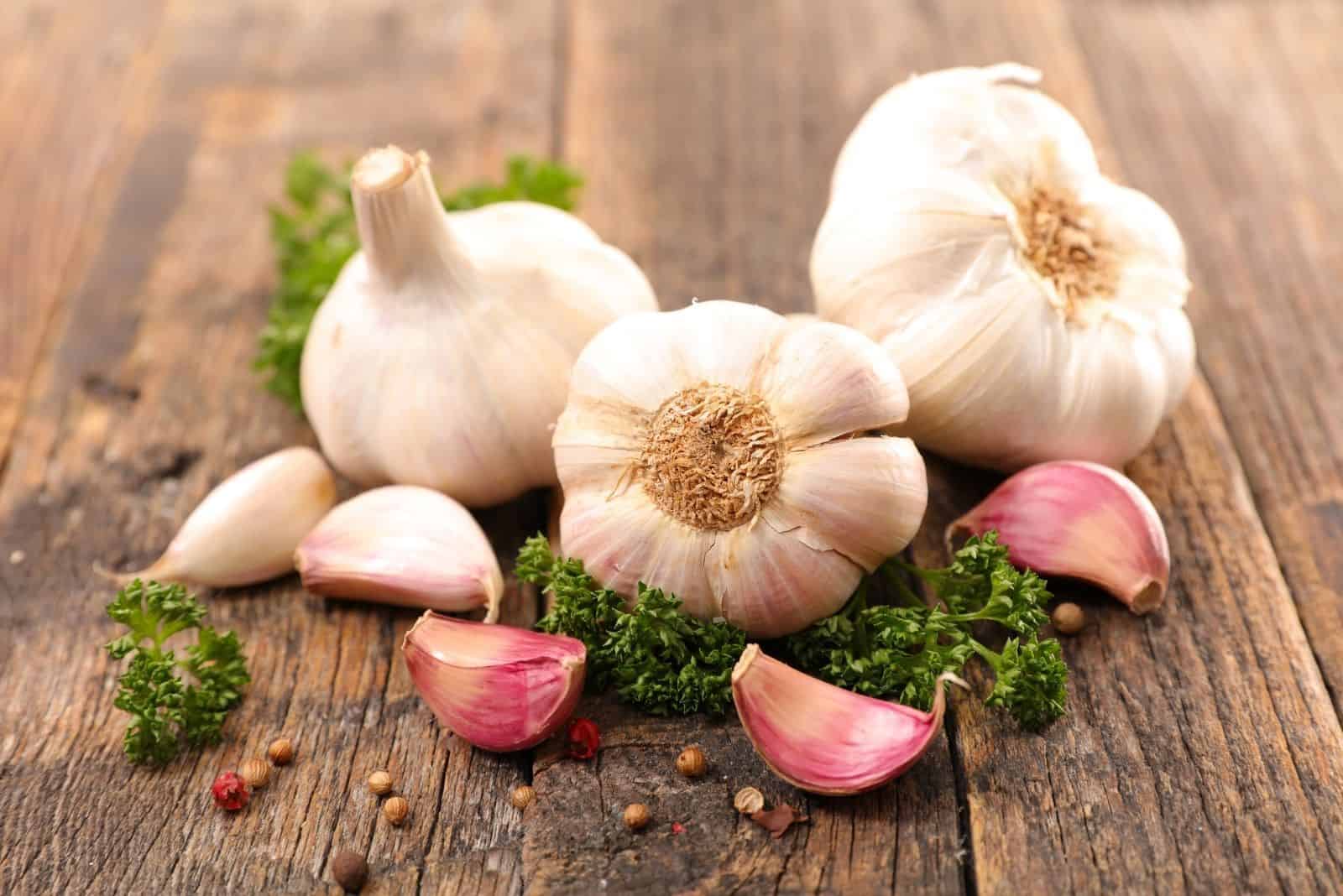
Garlic is the next ingredient. Even though garlic might be good for people, dogs metabolize certain foods differently than we do.
Garlic and other members of the allium family, including onions, contain thiosulfate which is toxic to dogs but not to humans.
Thiosulfate causes oxidative damage to red blood cells, resulting in hemolytic anemia. Symptoms of anemia include pale mucous membranes, rapid breathing, lethargy, weakness, jaundice, and dark colored urine.
Garlic toxicity also causes symptoms of gastrointestinal upset, including vomiting, diarrhea, loss of appetite, abdominal pain, depression, and dehydration.
So, if your pet accidentally eats a small portion of it, they will more than likely just have an upset stomach or will start to vomit.
If you are concerned that their symptoms are worsening or you’re not exactly sure how much they ate, take them to your vet immediately. Your dog’s health is most important.
Studies have found it takes approximately 15 to 30 grams of garlic per kilograms of body weight to produce harmful changes in a dog’s blood.
To put that into perspective, the average clove of supermarket garlic weighs between 3 and 7 grams, so your dog would have to eat a lot to get really sick.
However, some dogs are more sensitive to garlic toxicity than others, and consumption of a toxic dose spread out over a few days could also cause problems.
Olive oil
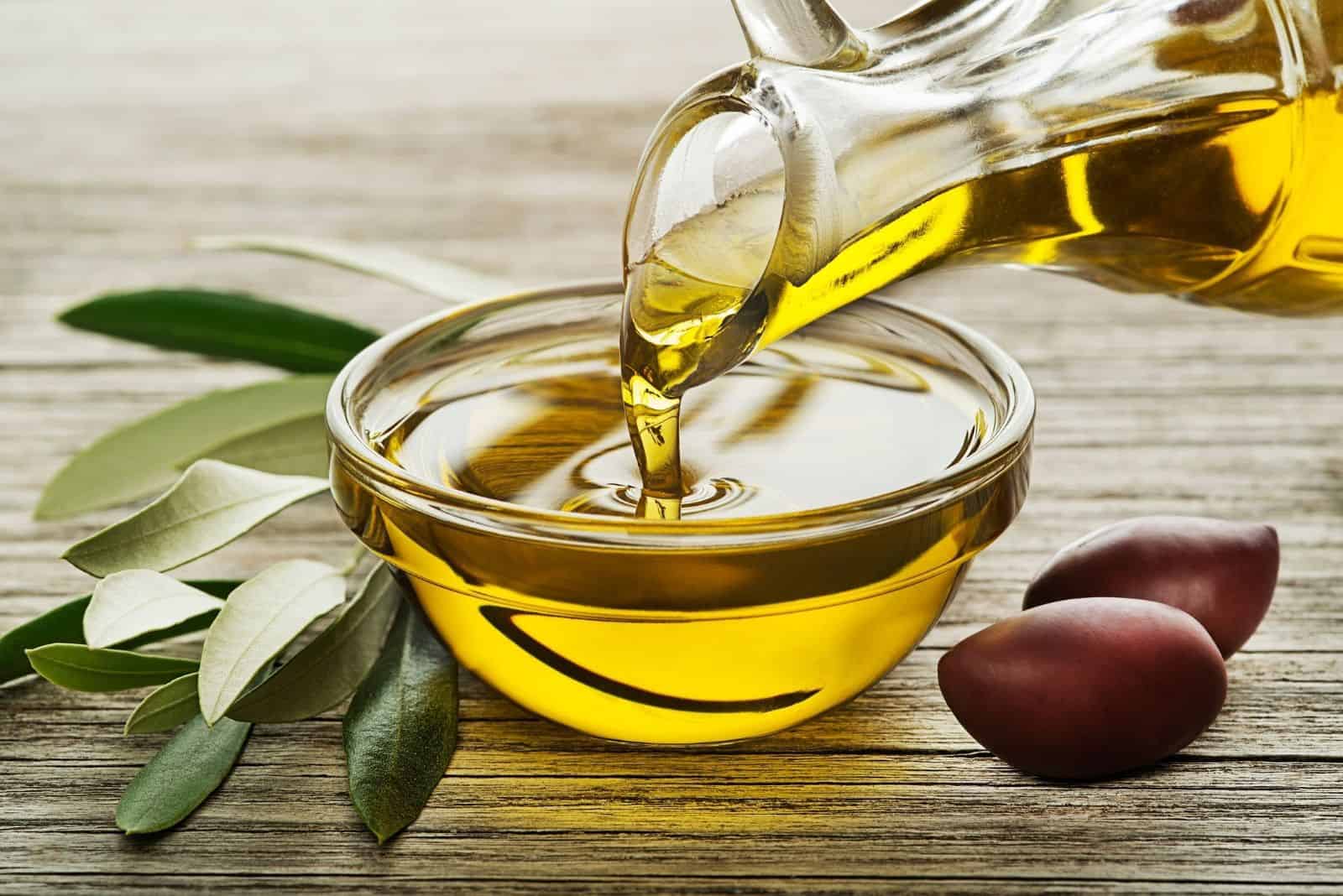
Olive oil has many health benefits for dogs. It contains phytonutrients, vitamin E, and omega-3 fatty acids that help keep your dog’s skin moisturized and well-nourished.
These nutrients also benefit your dog’s coat, adding shine and strength to their hair.
Adding small amounts of olive oil to your dog’s food can also help stimulate their digestive system as olive oil acts as a laxative.
However, if your dog is experiencing diarrhea or vomiting, olive oil should be avoided as it may exacerbate these conditions.
If your dog is refusing or hesitating to eat their food, try adding a splash of olive oil to change the taste and consistency.
This technique can be particularly effective if your dog is eating dry food or if it’s stale.
However, there are few risks of giving your dog olive oil. It can lead up to gastric upset, pancreatitis and to weight gain. So, be careful with serving it.
Pine Nuts
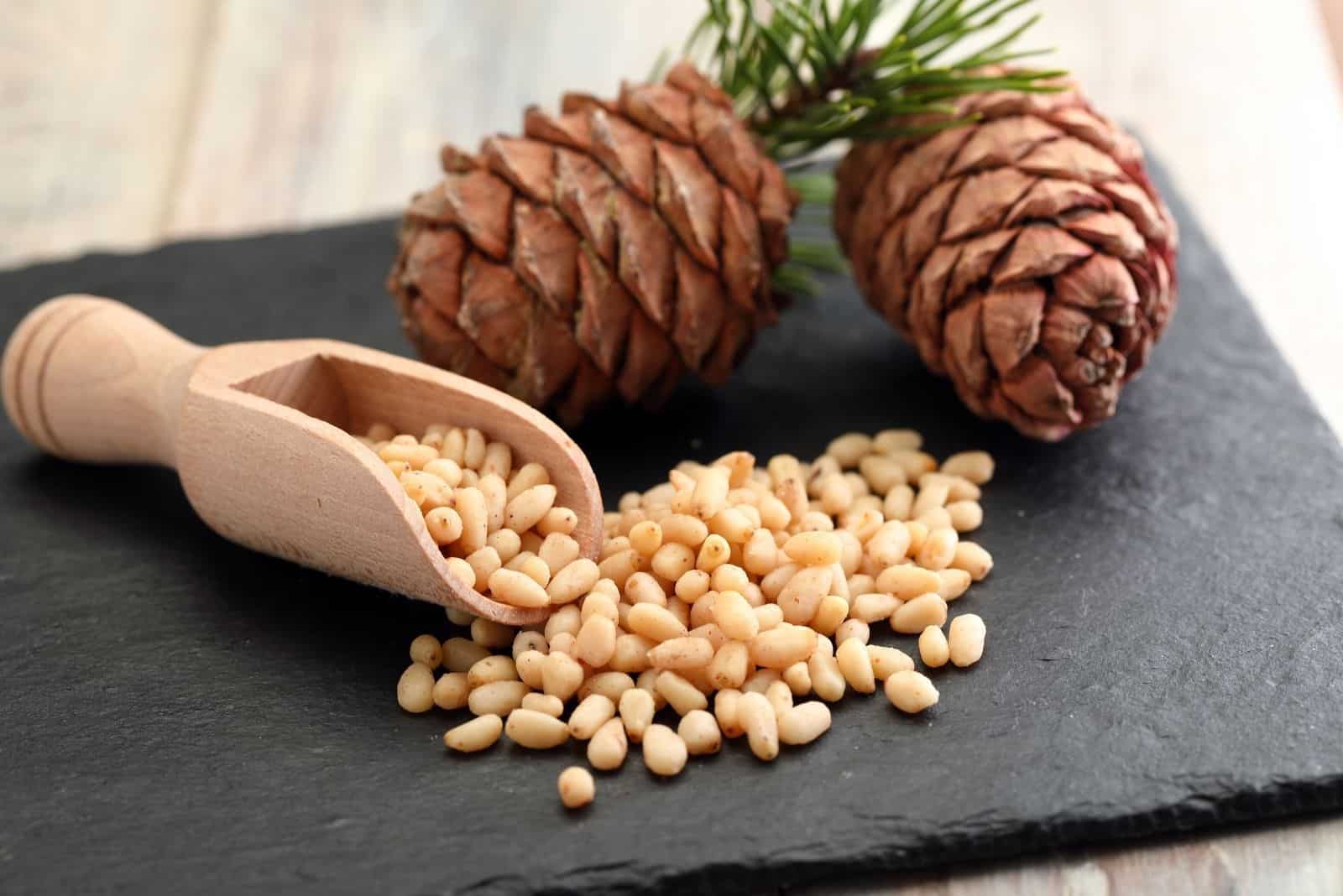
Although not toxic to dogs, pine nuts are not recommended as they are high in fat. Foods high in fat can cause gastric upset.
If your dog consumes a considerable amount of high-fat food, it can also cause pancreatitis and urinary tract infections.
Cheese
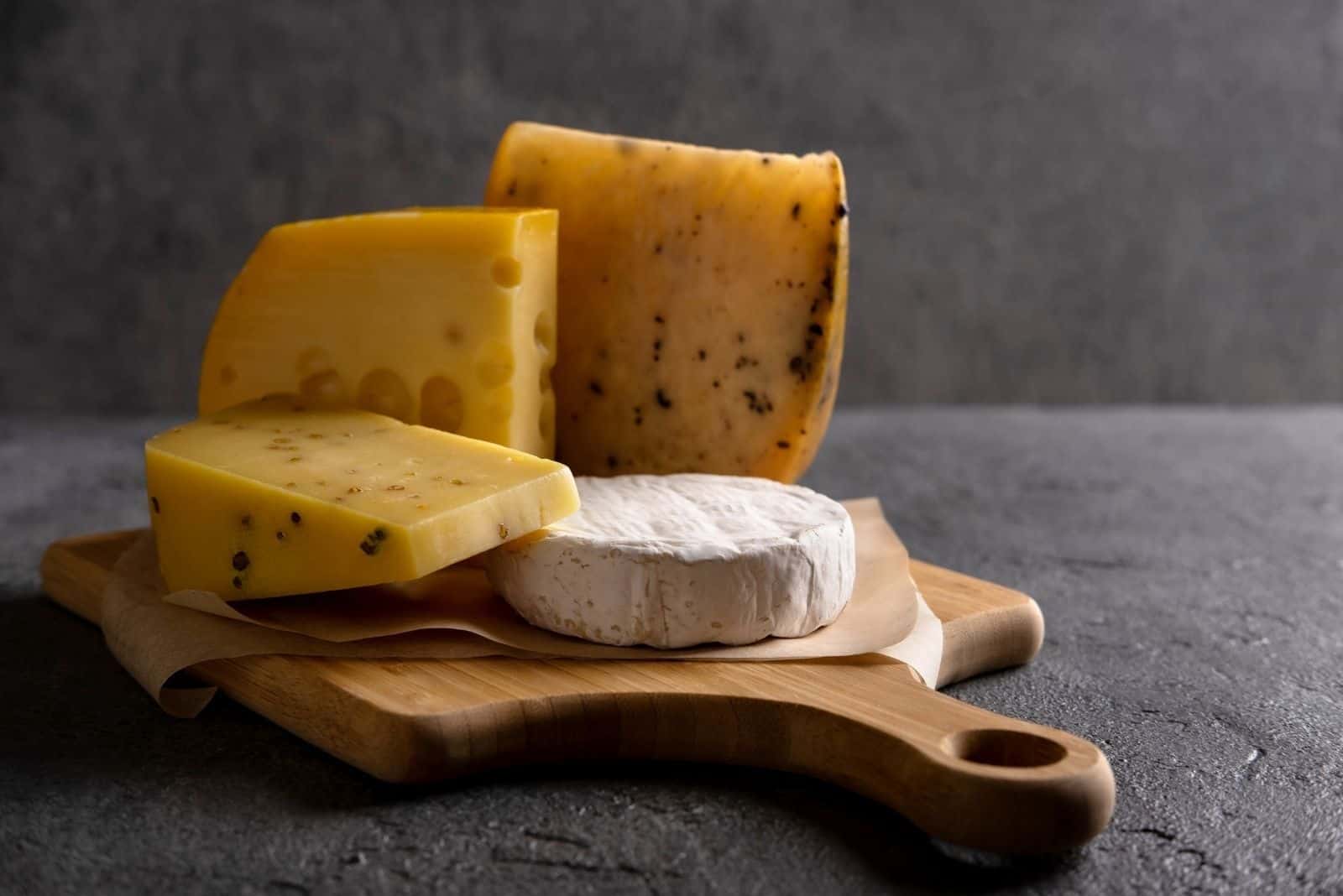
Dogs can eat cheese. In fact, cheese is often a great tool in dog training, especially for puppies.
While some dogs can eat cheese, and most dogs love it, many dogs can be intolerant of cheese. Even for dogs that are able to tolerate cheese, it is probably best fed in moderation.
Cheese contains protein, calcium, vitamin A, essential fatty acids, and B-complex vitamins.
This snack is also a good way to conceal pills for dogs that require medication.
While cheese can be safe to feed to your dog, there are some things to remember.
Cheese is high in fat, and feeding too much to your dog regularly can cause weight gain and lead to obesity.
Even more problematic, it could lead to pancreatitis, a serious and potentially fatal illness in dogs.
Therefore, it’s better to feed your dog low-fat cheeses, like mozzarella, cottage cheese, or a soft goat cheese to prevent possible side effects.
Not all dogs digest cheese well, and while cheese contains little lactose when compared to whole milk dogs with severe cases of lactose intolerance may have adverse reactions to cheese, even in small quantities.
Can Dogs Eat Basil Pesto?

Human pesto is not always safe for dogs as it often contains garlic which is toxic. However, you can make a special dog pesto that contains basil in it.
Basil can be very healthy for dogs as it’s high in antioxidants and might even help to relieve arthritis pain in dogs.
It is quite easy to make a homemade basil pesto with ingredients such as basil, pine nuts, parmesan cheese, olive oil, and a dash of salt. These ingredients are all safe for dogs in small quantities.
Keep in mind that once the basil is added in with other ingredients such as cheese and salt, it isn’t quite as healthy and therefore should be given only occasionally.
The additional cheese includes extra calories that plain basil does not. Be careful with the salt too; your dogs become easily dehydrated if they eat too much of it.
Is Pesto Safe For Dogs?
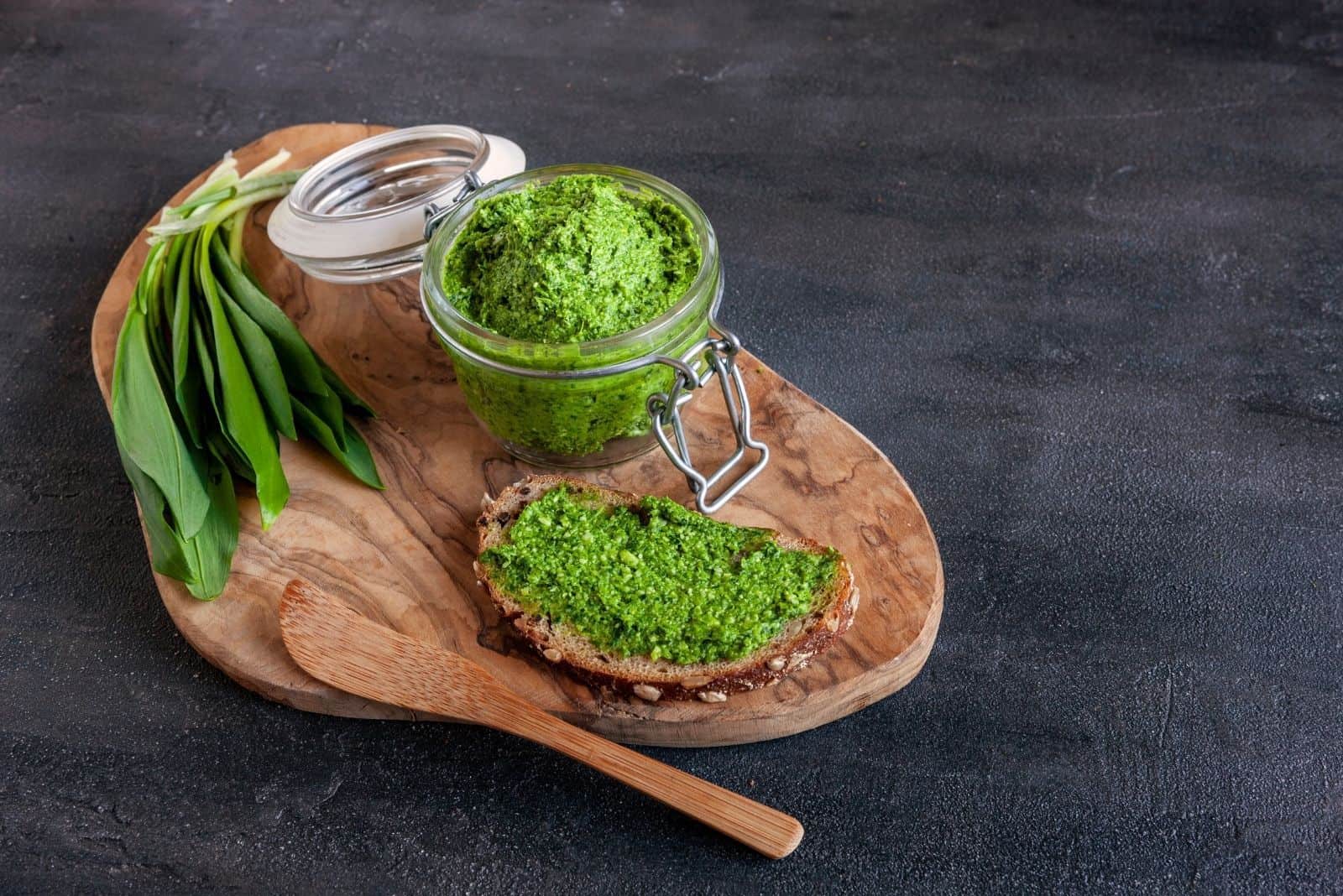
Human pesto is not safe for dogs, as mentioned before. Diy pesto, made exactly for dogs (without garlic) is safe for dogs.
There are other sauces, mentioned below, that can be used instead of pesto, which are good for dogs.
Cottage Cheese
If your dogs can tolerate lactose, then cottage cheese can be an excellent addition to a dog’s diet. It is high in both protein and calcium.
If you are introducing cottage cheese make sure to do so slowly, as lactose can cause gastric upset.
Plain Yogurt
Yogurt can help your dog’s digestive system and is generally used after an episode of diarrhea or vomiting. It is also high in protein and calcium.
Dog-Safe Applesauce
You can make this applesauce with water, apple and honey. Apples and honey both have nutritional benefits for dogs.
Apples contain fiber, which is beneficial for digestion. It is a great additive to dog treats and works well for binding ingredients together.
Honey is safe for dogs to eat in small quantities.
It contains natural sugars and small amounts of vitamins and minerals, and is used as a sweetener in many foods and beverages. Honey should not be given to diabetic or obese dogs.
Peanut Butter
Most peanut butter is safe for dogs to eat, and in moderation peanut butter can be an excellent source of protein and healthy fats, vitamins B and E, and niacin.
The healthiest option is unsalted peanut butter or homemade peanut butter, as high sodium levels can be problematic for dogs, and as an added bonus, homemade peanut butters do not contain extra sugar and other additives.
Other Fruits And Vegetables Good For Your Dog
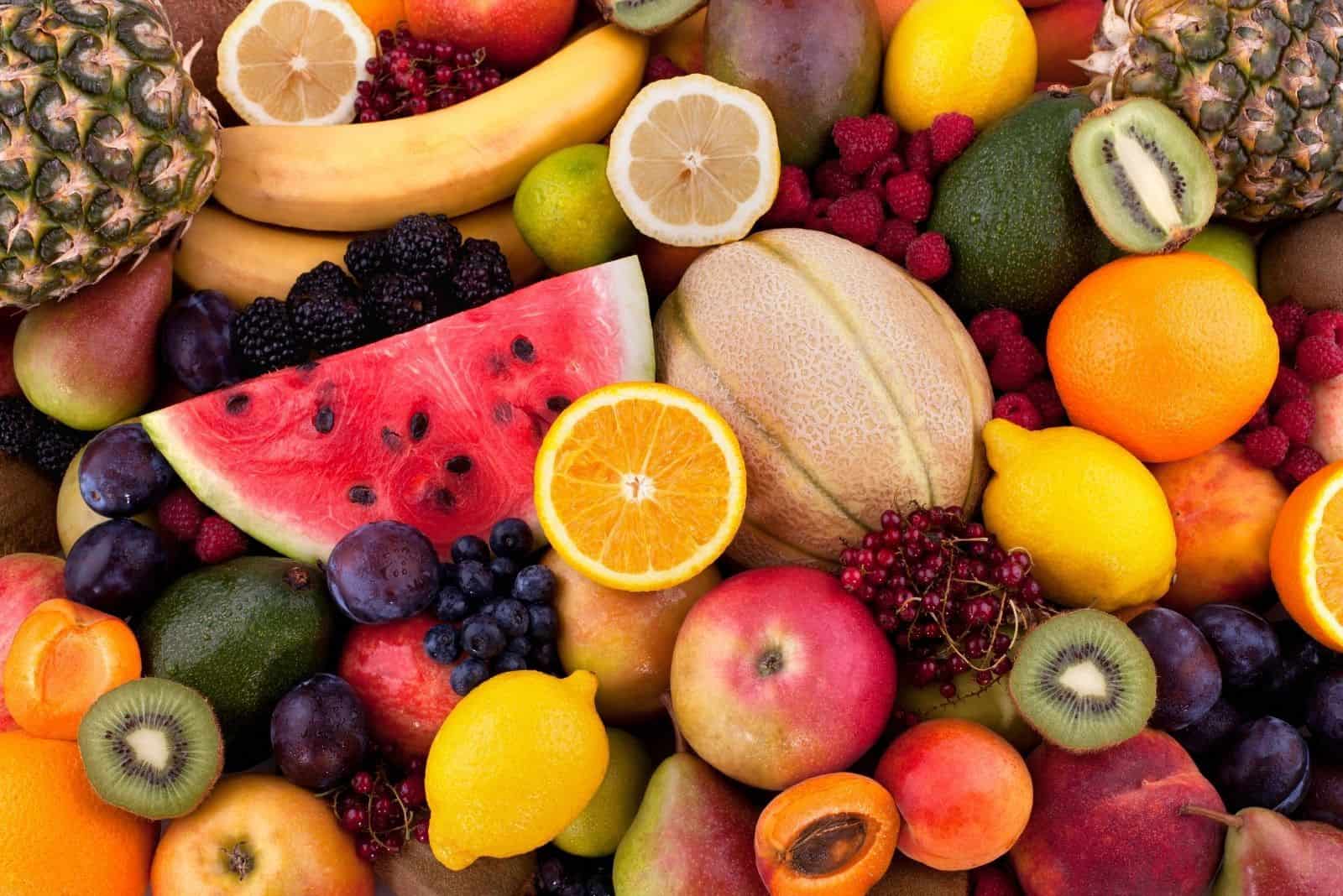
While there are a handful of dangerous food items you need to make sure your dog doesn’t eat, there are plenty of safe food options to give them.
These food options are not only safe to give your pet, but are often loved by dogs, so they’ll consume them happily.
They’re also filled with plenty of antioxidants, vitamins, and minerals so they’ll provide your pet with plenty of health benefits.
Below are some options to consider giving your pet.
You can either mix them in your food processor and prepare them together, cook them alone, or simply find dog recipes online.
Fruits Dog Can Eat
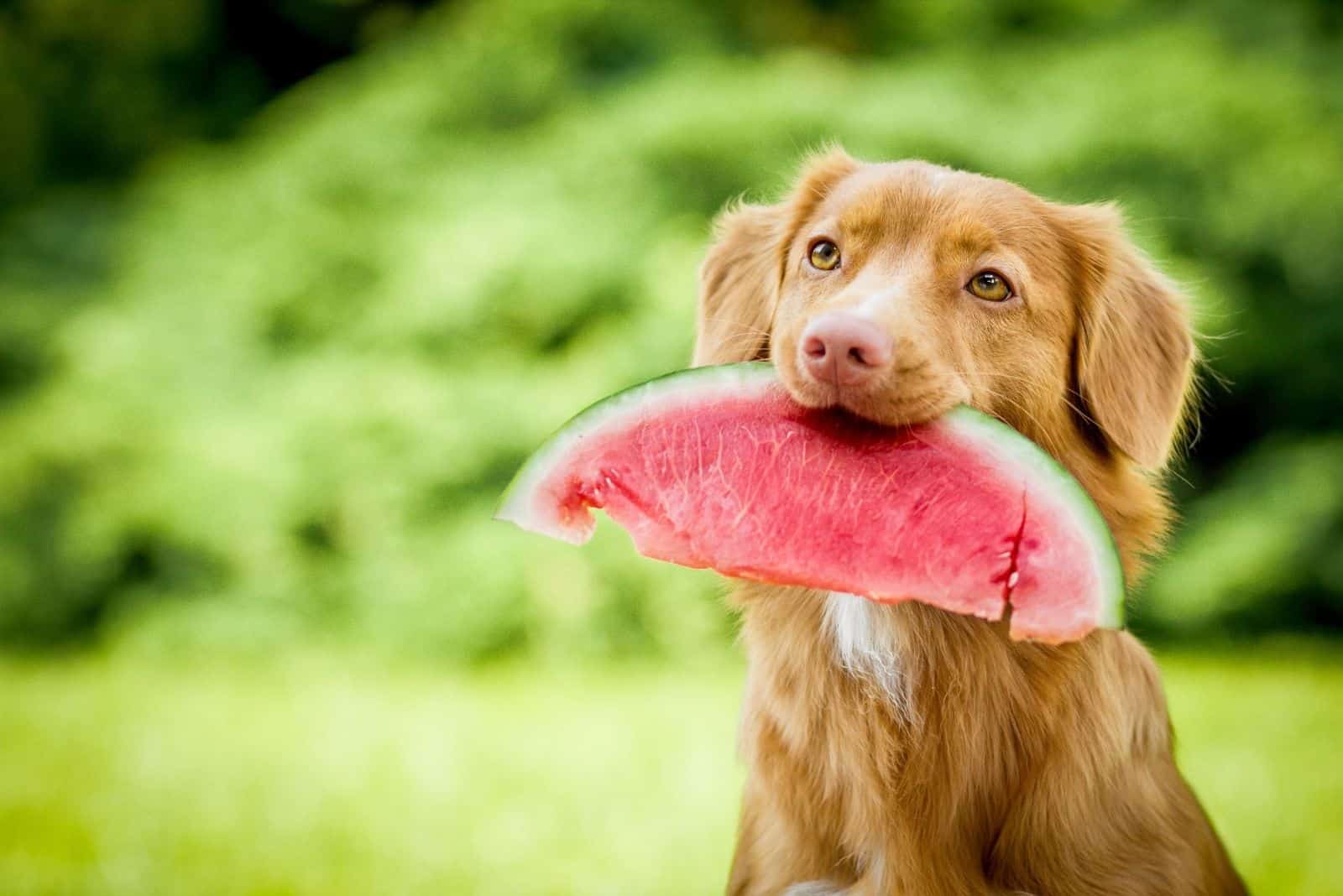
Blueberries
These are a great snack for dogs that are filled with antioxidants, which prevent cell damage in humans and canines alike.
They also have plenty of fiber which can help their digestive system function well.
Apples
Apples are an excellent source of vitamins A and C, as well as fiber for your dog.
They are low in protein and fat, making them the perfect snack for senior dogs. Just be sure to remove the seeds and core first.
Bananas
In moderation, bananas are a great low-calorie treat for dogs. They’re high in potassium, vitamins, biotin, fiber, and copper.
They are low in cholesterol and sodium, but because of their high sugar content, bananas should be given as a treat, not part of your dog’s main diet.
Cantaloupe
Cantaloupe is packed with nutrients, low in calories, and a great source of water and fiber.
It is, however, high in sugar, so should be shared in moderation, especially for dogs who are overweight or have diabetes.
Cucumber
Cucumbers are especially good for overweight dogs, as they hold little to no carbohydrates, fats, or oils and they can even boost energy levels.
They’re loaded with vitamins K, C, and B1, as well as potassium, copper, magnesium, and biotin.
Mango
Mango is an excellent source of four different vitamins: A, B6, C, and E.
They also have potassium and both beta-carotene and alpha-carotene. As with most fruits, remove the hard pit first, as it contains small amounts of cyanide and can become a choking hazard.
Mango is high in sugar, so use it as an occasional treat.
Oranges
Oranges are fine for dogs to eat because they are a source of vitamin C, potassium, and fiber. The juicy flesh of an orange can be a tasty treat for your dog in small quantities.
Vets do recommend tossing the peel and only offering your dog the flesh of the orange, minus any seeds.

Photo from @pumpkin_montblanc
Peaches
Small amounts of cut-up fresh or frozen peaches are a great source of fiber and vitamin A, and can even help fight infections, but the pit contains cyanide.
As long as you completely cut around the pit first, fresh peaches can be a great summer treat.
Pears
Pears are a great snack because they’re high in copper, vitamins C and K, and fiber.
Just be sure to cut pears into bite-size chunks and remove the pit and seeds first, as the seeds contain traces of cyanide.
Pineapple
A few chunks of pineapple is a great sweet treat for dogs, as long as the prickly outside peel and crown are removed first.
This fruit is full of vitamins, minerals, and fiber. It also contains bromelain, an enzyme that makes it easier for dogs to absorb proteins.
Strawberries
Strawberries are full of fiber and vitamin C. Along with that, they also contain an enzyme that can help whiten your dog’s teeth as he or she eats them.
They contain sugar, so be sure to give them in moderation.
Watermelon
It’s important to remove the rind and seeds first, as they can cause intestinal blockage, but watermelon flesh is otherwise safe for dogs.
It’s full of vitamin A, B-6, and C, as well as potassium. Watermelon is 92 percent water, so it’s a great way to help keep your dog hydrated on hot summer days.
Vegetables Dogs Can Eat
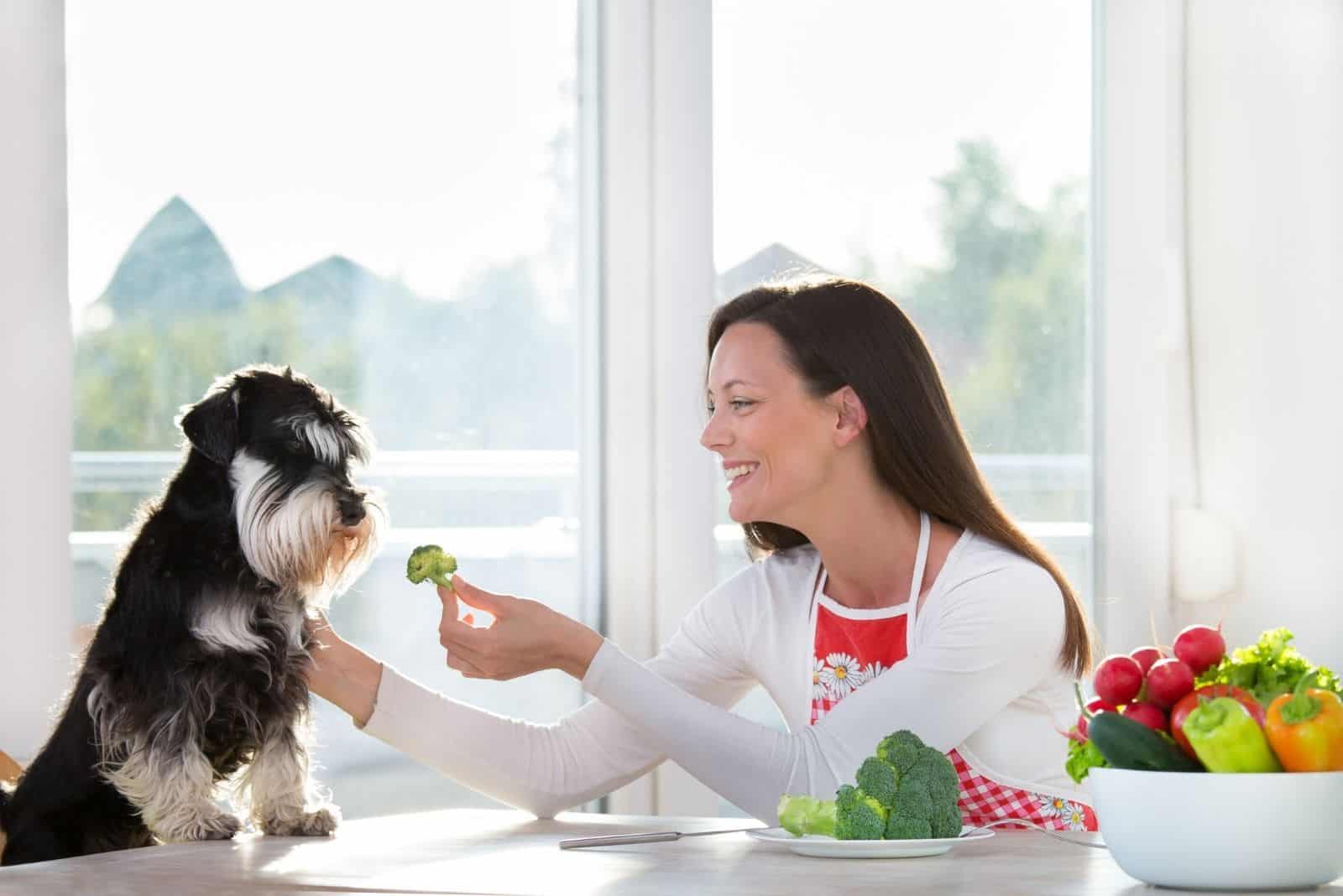
Broccoli
Broccoli is safe for dogs to eat in very small quantities and is best served as an occasional treat. It is high in fiber and vitamin C and low in fat.
However, Broccoli florets contain isothiocyanates, which can cause mild-to-potentially-severe gastric irritation in some dogs.
Brussels sprouts are loaded with nutrients and antioxidants that are great for humans and dogs, alike.
Don’t overfeed them to your dog, however, because they can cause lots of gas.
Carrots
Carrots are an excellent low-calorie snack that is high in fiber and beta-carotene, which produces vitamin A.
Plus, crunching on this orange veggie is great for your dog’s teeth (and fun).
Celery
In addition to vitamins A, B, and C, this vegetable contains the nutrients needed to promote a healthy heart and even fight cancer.
Green beans
All types of green beans are safe for dogs to eat, as long as they are plain. Green beans are full of important vitamins and minerals and they’re also full of fiber and low in calories.
Peas
Peas have several vitamins, minerals, and are rich in protein and high in fiber. You can feed your dog fresh or frozen peas, but avoid canned peas with added sodium.
Spinach
Dogs can eat spinach, but in small quantities. Spinach is high in oxalic acid, which blocks the body’s ability to absorb calcium and can lead to kidney damage.
While your dog would probably have to eat a very large amount of spinach to have this problem, it might be best to go with another vegetable.
Sweet potatoes
This vegetable not only helps dogs to have a healthy digestive system, but can also reduce inflammation and provide their body with plenty of vitamins.
To Sum Up
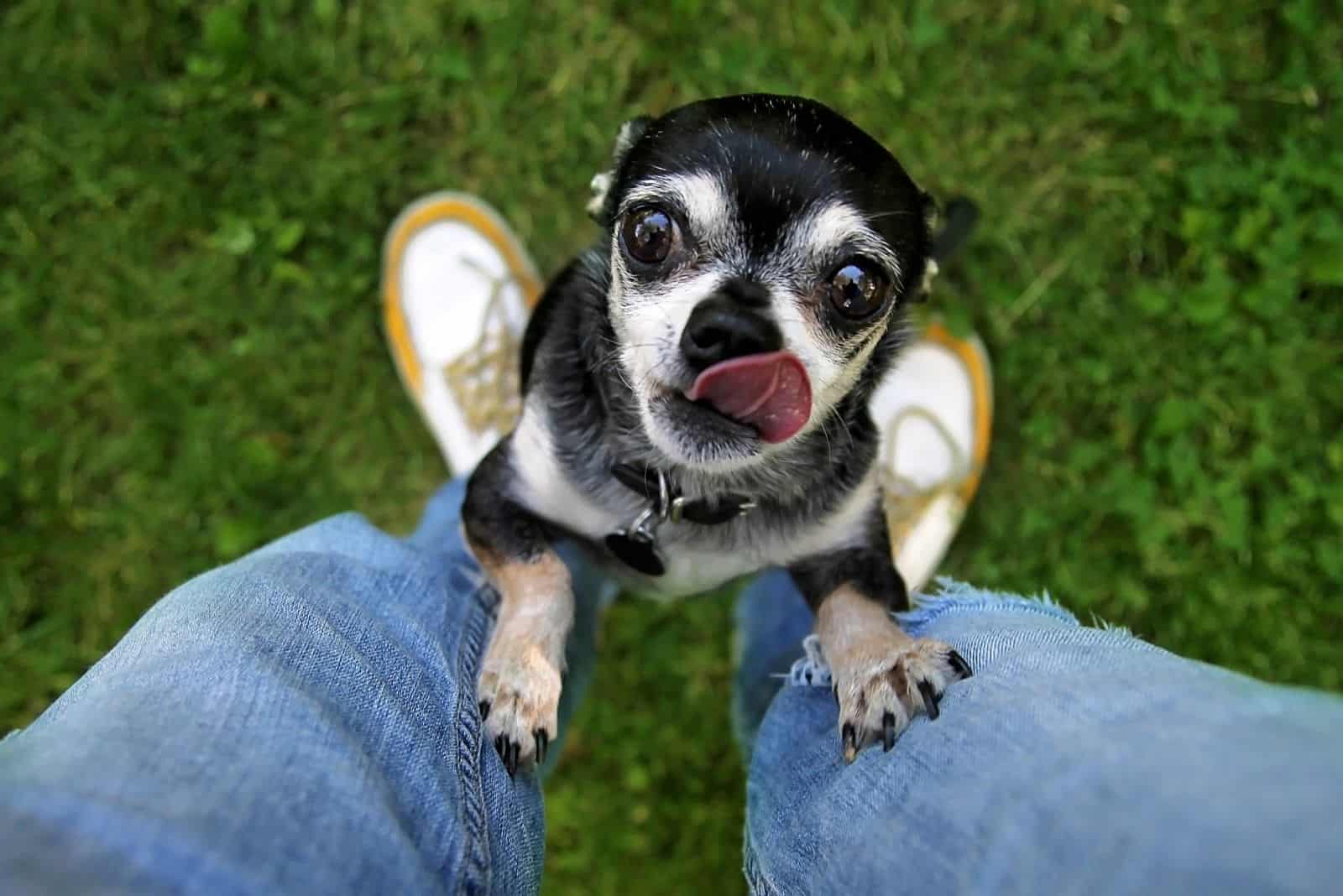
So, can dogs eat pesto?
The correct answer is no! But, there is an exception. If you make a homemade pesto, without garlic, your dog can have it.
As a responsible pet owner, you should know which human food is good for your dog, which is not. Check our list and learn something new.
The quality of the food you feed your dog matters as well. Avoid generic “meat byproducts,” sugars, excess sodium, and unnecessary fillers.
Look for whole ingredients and responsible sourcing practices from your dog food to help extend your dog’s health.
Be aware of the simple fact – dogs who eat healthy food live longer.
Your time together is precious, so maintain healthy habits, keep your dogs active in the body, give them healthy food and savor every minute.
